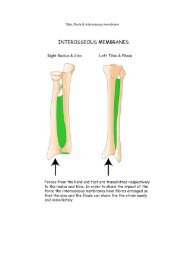GSM 11.11 version 6.2.0 - TTFN Smart card pages
GSM 11.11 version 6.2.0 - TTFN Smart card pages
GSM 11.11 version 6.2.0 - TTFN Smart card pages
- No tags were found...
You also want an ePaper? Increase the reach of your titles
YUMPU automatically turns print PDFs into web optimized ePapers that Google loves.
(<strong>GSM</strong> <strong>11.11</strong> <strong>version</strong> <strong>6.2.0</strong> Release 1997)9TS 100 977 V<strong>6.2.0</strong> (1999-05)1 ScopeThe present document defines the interface between the Subscriber Identity Module (SIM) and the Mobile Equipment(ME) for use during the network operation phase of <strong>GSM</strong> as well as those aspects of the internal organization of theSIM which are related to the network operation phase. This is to ensure interoperability between a SIM and an MEindependently of the respective manufacturers and operators. The concept of a split of the Mobile Station (MS) intothese elements as well as the distinction between the <strong>GSM</strong> network operation phase, which is also called <strong>GSM</strong>operations, and the administrative management phase are described in the <strong>GSM</strong> 02.17 [6].The present document defines:- the requirements for the physical characteristics of the SIM, the electrical signals and the transmission protocols;- the model which shall be used as a basis for the design of the logical structure of the SIM;- the security features;- the interface functions;- the commands;- the contents of the files required for the <strong>GSM</strong> application;- the application protocol.Unless otherwise stated, references to <strong>GSM</strong> also apply to DCS 1800.The present document does not specify any aspects related to the administrative management phase. Any internaltechnical reallocation of either the SIM or the ME are only specified where these reflect over the interface. It does notspecify any of the security algorithms which may be used.The present document defines the SIM/ME interface for <strong>GSM</strong> Phase 2. While all attempts have been made to maintainphase compatibility, any issues that specifically relate to Phase 1 should be referenced from within the relevant Phase 1specification.2 ReferencesThe following documents contain provisions which, through reference in this text, constitute provisions of the presentdocument.• References are either specific (identified by date of publication, edition number, <strong>version</strong> number, etc.) ornon-specific.• For a specific reference, subsequent revisions do not apply.• For a non-specific reference, the latest <strong>version</strong> applies.• A non-specific reference to an ETS shall also be taken to refer to later <strong>version</strong>s published as an EN with the samenumber.• For this Release 1997 document, references to <strong>GSM</strong> documents are for Release 1997 <strong>version</strong>s (<strong>version</strong> 6.x.y).[1] <strong>GSM</strong> 01.02: "Digital cellular telecommunications system (Phase 2+); General description of a<strong>GSM</strong> Public Land Mobile Network (PLMN)".[2] <strong>GSM</strong> 01.04: "Digital cellular telecommunications system (Phase 2+); Abbreviations andacronyms".[3] <strong>GSM</strong> 02.07: "Digital cellular telecommunications system (Phase 2+); Mobile Stations (MS)features".[4] <strong>GSM</strong> 02.09: "Digital cellular telecommunications system (Phase 2+); Security aspects".[5] <strong>GSM</strong> 02.11: "Digital cellular telecommunications system (Phase 2+); Service accessibility".[6] <strong>GSM</strong> 02.17: "Digital cellular telecommunications system (Phase 2+); Subscriber Identity Modules(SIM) Functional characteristics".ETSI








